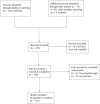A comparison of COVID-19, SARS and MERS
- PMID: 32879801
- PMCID: PMC7443081
- DOI: 10.7717/peerj.9725
A comparison of COVID-19, SARS and MERS
Abstract
In mid-December 2019, a novel atypical pneumonia broke out in Wuhan, Hubei Province, China and was caused by a newly identified coronavirus, initially termed 2019 Novel Coronavirus and subsequently severe acute respiratory syndrome coronavirus 2 (SARS-CoV-2). As of 19 May 2020, a total of 4,731,458 individuals were reported as infected with SARS-CoV-2 among 213 countries, areas or territories with recorded cases, and the overall case-fatality rate was 6.6% (316,169 deaths among 4,731,458 recorded cases), according to the World Health Organization. Studies have shown that SARS-CoV-2 is notably similar to (severe acute respiratory syndrome coronavirus) SARS-CoV that emerged in 2002-2003 and Middle East respiratory syndrome coronavirus (MERS-CoV) that spread during 2012, and these viruses all contributed to global pandemics. The ability of SARS-CoV-2 to rapidly spread a pneumonia-like disease from Hubei Province, China, throughout the world has provoked widespread concern. The main symptoms of coronavirus disease 2019 (COVID-19) include fever, cough, myalgia, fatigue and lower respiratory signs. At present, nucleic acid tests are widely recommended as the optimal method for detecting SARS-CoV-2. However, obstacles remain, including the global shortage of testing kits and the presentation of false negatives. Experts suggest that almost everyone in China is susceptible to SARS-CoV-2 infection, and to date, there are no effective treatments. In light of the references published, this review demonstrates the biological features, spread, diagnosis and treatment of SARS-CoV-2 as a whole and aims to analyse the similarities and differences among SARS-CoV-2, SARS-CoV and MERS-CoV to provide new ideas and suggestions for prevention, diagnosis and clinical treatment.
Keywords: COVID-19; Clinical presentations; Epidemiology; Laboratory diagnosis; MERS-CoV; Radiological features; SARS-CoV.
© 2020 Hu et al.
Conflict of interest statement
The authors declare that they have no competing interests.
Figures
References
-
- Abd El Wahed A, Patel P, Heidenreich D, Hufert FT, Weidmann M. Reverse transcription recombinase polymerase amplification assay for the detection of middle East respiratory syndrome coronavirus. PLOS Currents. 2013;5:e8364. doi: 10.1371/currents.outbreaks.62df1c7c75ffc96cd59034531e2e8364. - DOI - PMC - PubMed
-
- Aggarwal G, Lippi G, Michael Henry B. Cerebrovascular disease is associated with an increased disease severity in patients with coronavirus disease 2019 (COVID-19): a pooled analysis of published literature. International Journal of Stroke. 2020;15(4):385–389. doi: 10.1177/1747493020921664. - DOI - PubMed
-
- Ahmadzadeh J, Mobaraki K, Mousavi SJ, Aghazadeh-Attari J, Mirza-Aghazadeh-Attari M, Mohebbi I. The risk factors associated with MERS-CoV patient fatality: a global survey. Diagnostic Microbiology and Infectious Disease. 2020;96(3):114876. doi: 10.1016/j.diagmicrobio.2019.114876. - DOI - PMC - PubMed
LinkOut - more resources
Full Text Sources
Research Materials
Miscellaneous




